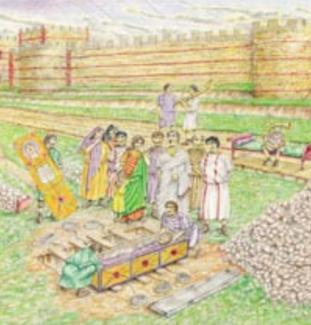
'Well, can you see anything?' 'Yes, wonderful things' (Howard Carter's reply to Lord Caernarvon upon first peering into the tomb of Tutankhamen).
The tomb and its grave goods denoted the wealth and status of the king, but also expressed his peoples' hopes for him in the afterlife. Winchester people in the Roman period were buried with lesser treasures but for similar reasons. Many of these objects- glass, shale and pottery vessels, brooches, pins and rings, amulets and good luck charms- have been excavated in advance of redevelopment and are displayed in the Venta Belgarum Gallery at the City Museum.
According to Roman law, no burial could take place within the city walls, so cemeteries were sited in the suburbs. If you stood at the North Gate in the 4th century AD, you would see the cemetery stretching out along the eastern side of the Roman road to Cirencester (Corinium) as far as where Lankhills School is today. In medieval times, Worthy Lane was called Bonestraete because no-one could dig a hole there without coming across a Roman skeleton.
There was another graveyard along Romsey Road, roughly where West Hill cemetery is now, and the partially silted up ditch of the old Iron Age settlement enclosure was also used for burial to the west of the town. In the northern cemetery and at West Hill, there were too few infant burials to give a balanced sample of the population, but, curiously, the missing babies turned up in the Iron Age enclosure ditch- about 80% infants and only 20% older age groups.
Outside the East Gate, parts of the eastern Roman cemetery have been found at Water Lane, Chester Road, St John's Street, Beggar's Lane and St Martin's Close. This area has produced some of the best grave goods, although the late Roman graves found there often had none at all, as by this time the Roman empire had become Christian.
The earliest cemetery to be established in the late 60s AD, a time when cremation was the preferred funerary rite, was the one outside the North Gate. As the available space was filled, the active area of burial moved northwards away from the town ending at the beginning of the 5th century at Lankhills, some 500m distant from the gate. Around the middle of the 3rd century when cremation began to decline in favour of unburnt burial, the western and eastern areas came into use, and a new cemetery was established in the north, to the west of the old one.
At first, the cemetery must have been intended for the inhabitants of the new Roman town, but some scholars believe that the later cemeteries were seen as a focus of the group identity of the entire civitas or tribe, and drew their populations both from the town and rural areas outside it. Isotope analysis on the teeth of some of the skeletons has shown that not everyone in late Roman Winchester was a native Briton- some people came here from Mediterranean areas and eastern Europe.
One man, found in a lead coffin on the site of the old Eagle Hotel had 'Mediterranean' early dentition and 'British' later dentition, suggesting that he came to Winchester before he reached adulthood, but was born and spent some of his childhood in Italy or Spain. In his hand was a coin of Constantine the Great bearing the motif of the Unconquered Sun on the reverse. This may have been to pay the ferryman, but bearing in mind that Constantine himself was a Christian, the coin might signify that the man had been some kind of official of the Roman empire. His story has featured in a 'Meet the Ancestors' programme, and the reconstruction of his face, kindly donated to us by the BBC, is displayed at the City Museum.


